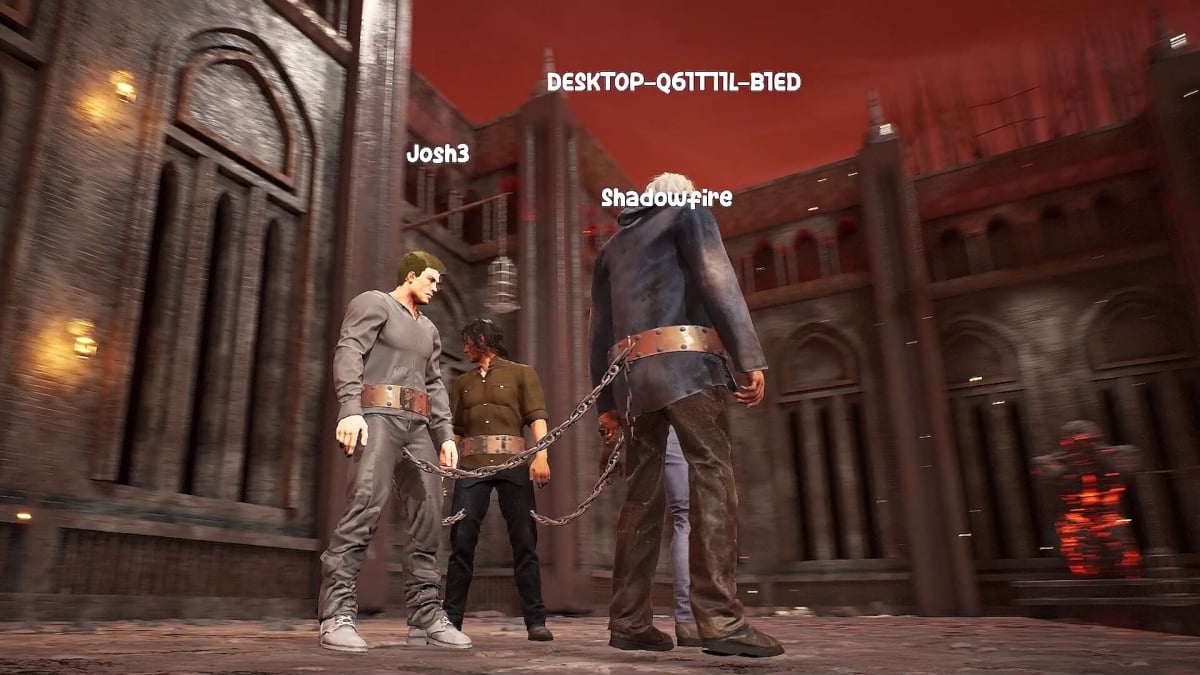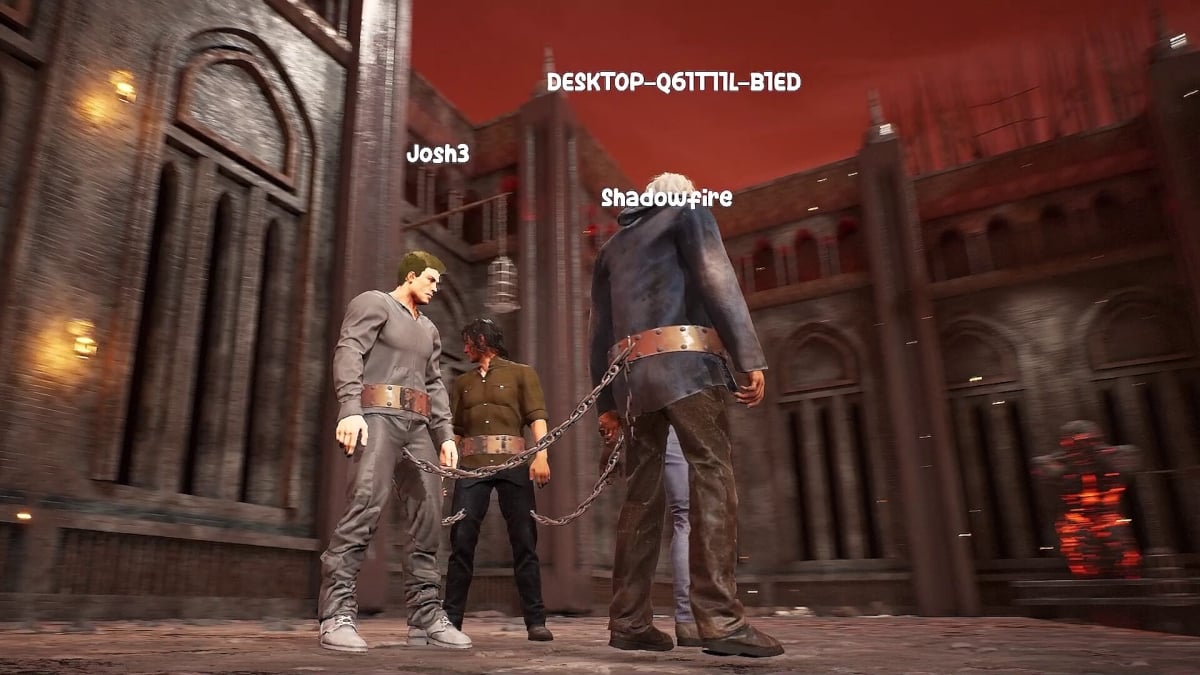In the realm of cooperative gaming, the “game where you are chained together” concept presents a captivating blend of challenge, strategy, and camaraderie. With players literally bound to one another, this unique mechanic fosters teamwork, communication, and a dynamic gameplay experience that unfolds in unexpected ways.
The chained-together mechanic introduces a myriad of gameplay possibilities. From navigating intricate levels filled with obstacles and environmental hazards to overcoming conflicts and fostering cooperation among characters, this innovative concept offers a rich tapestry of challenges and rewards.
Game Mechanics

In the realm of gaming, the concept of being chained together presents a unique gameplay mechanic that adds a layer of challenge and cooperation. This mechanic involves connecting two or more characters, typically through a physical or ethereal bond, and forcing them to navigate the game environment in tandem.
There are several ways in which the chaining mechanic can be implemented in games. One common approach is through a literal chain or rope that physically binds the characters together. This type of chaining restricts movement and forces players to coordinate their actions carefully to avoid becoming entangled or separated.
Another implementation involves an ethereal or magical bond that links the characters, allowing them to remain connected even when physically apart. This type of chaining provides greater freedom of movement but still requires players to consider the impact of their actions on their chained partner.
Examples
Numerous games have successfully utilized the chaining mechanic to enhance gameplay. One notable example is the classic puzzle game “Portal 2,” where players control two robots, Atlas and P-body, who are connected by a long energy beam. This chaining mechanic forces players to think strategically and coordinate their movements to solve puzzles and overcome obstacles.
Another example is the action-adventure game “A Way Out,” where players control two characters, Leo and Vincent, who are chained together during a prison escape. The chaining mechanic in this game adds tension and urgency to the gameplay, as players must work together to navigate through dangerous environments and avoid detection by guards.
Cooperative Gameplay
Cooperative gameplay in a game where players are chained together presents unique challenges and opportunities. Players must work together effectively to overcome obstacles and achieve their goals.
One of the key challenges of cooperative gameplay is communication. Players must be able to communicate clearly and concisely in order to coordinate their actions and avoid mistakes. This can be difficult, especially in fast-paced or stressful situations.
Strategies for Effective Communication
- Establish clear roles and responsibilities for each player.
- Use simple and direct language to avoid misunderstandings.
- Be patient and understanding, especially with new players.
- Use visual cues, such as gestures or markers, to communicate non-verbally.
Another challenge of cooperative gameplay is coordination. Players must be able to work together seamlessly to achieve their goals. This requires a high level of trust and cooperation between players.
Strategies for Effective Coordination
- Plan your actions in advance and discuss them with your teammates.
- Be flexible and adaptable to changing circumstances.
- Don’t be afraid to ask for help or advice from your teammates.
- Celebrate your successes together and learn from your mistakes.
Cooperative gameplay can be a rewarding and enjoyable experience. It fosters teamwork and collaboration, and it can help players develop valuable communication and coordination skills.
Level Design
Level design plays a crucial role in enhancing or hindering the chained-together mechanic. It can influence the pace, difficulty, and overall enjoyment of the gameplay.The size of the level directly affects the players’ movement and interaction. Larger levels provide more space for exploration and maneuvering, allowing players to strategize and utilize the environment to their advantage.
Smaller levels, on the other hand, create a more intense and claustrophobic experience, forcing players to adapt quickly and rely heavily on teamwork.Obstacles and environmental hazards add depth and challenge to the level design. Well-placed obstacles can encourage cooperation and problem-solving, as players must work together to overcome them.
Hazards such as traps, pits, or moving platforms can create a sense of urgency and add an element of risk to the gameplay. However, excessive or poorly designed obstacles can hinder the flow of the game and frustrate players.To optimize the gameplay experience, level designers should consider the following suggestions:
- Vary the level size to create different pacing and challenges.
- Incorporate obstacles that promote teamwork and strategic thinking.
- Introduce environmental hazards sparingly and ensure they enhance the gameplay rather than hinder it.
- Provide clear visual cues and indicators to help players navigate the level effectively.
- Test levels thoroughly to ensure they are balanced and enjoyable for players of all skill levels.
By carefully crafting level designs that complement the chained-together mechanic, developers can create a compelling and immersive gameplay experience that keeps players engaged and challenged throughout their journey.
Character Interactions
The chained-together mechanic profoundly influences character interactions, introducing a unique dynamic that drives gameplay. Players must constantly negotiate, cooperate, and make sacrifices to overcome obstacles.
The physical connection creates both opportunities for cooperation and potential for conflict. Players can assist each other by sharing resources, coordinating movements, and providing cover. However, the chain can also hinder progress, as one player’s actions can restrict the others.
This tension creates a delicate balance that requires players to communicate effectively and adapt to changing situations.
Conflict
- The chain can lead to frustration and resentment if players have different goals or playstyles. One player may want to rush ahead while another prefers a more cautious approach. These differences can escalate into arguments and sabotage, hindering the team’s progress.
- Players may also compete for resources, such as health packs or ammunition. This can lead to betrayal and mistrust, as players may prioritize their own survival over the team’s well-being.
Cooperation
- The chain encourages cooperation as players realize that they are stronger together. They must learn to communicate effectively, plan strategies, and support each other in combat. This shared experience can foster a sense of camaraderie and mutual respect.
- The chain can also facilitate strategic decision-making. Players can use the chain to create tactical formations, such as using one player as a shield while another attacks. This teamwork can significantly increase the team’s effectiveness.
Betrayal
- In some cases, the chain can be used as a weapon for betrayal. A player may intentionally hinder their teammates’ progress or even sacrifice them to save themselves. This can lead to feelings of anger, distrust, and a breakdown in the team’s morale.
- Betrayal can also occur when players have different objectives. For example, one player may be tasked with retrieving a specific item while another is focused on completing a different mission. This conflict of interests can lead to players working against each other.
Narrative Potential
The chained-together mechanic in video games offers unique storytelling opportunities that can enhance player engagement and emotional connections. By forcing characters to remain in close proximity, it creates a sense of interdependence and vulnerability, which can be leveraged to generate tension, suspense, and profound emotional moments.
One of the key narrative advantages of this mechanic is its ability to create a sense of shared struggle and camaraderie. As players navigate challenges and obstacles together, they must learn to communicate effectively, coordinate their actions, and rely on each other for support.
This shared experience can foster a strong sense of connection and empathy between the characters, making their triumphs and setbacks all the more impactful.
Emotional Connections
The chained-together mechanic can also be used to evoke powerful emotional responses from players. By forcing characters to confront their fears and vulnerabilities in the presence of others, it creates opportunities for genuine moments of intimacy and growth. Players may witness their characters comforting each other during moments of crisis, offering encouragement in the face of adversity, or simply sharing their innermost thoughts and feelings.
These shared experiences can create a deep emotional connection between players and their characters, making the narrative all the more resonant.
Examples
Several games have successfully leveraged the chained-together mechanic for narrative purposes. One notable example is “Brothers: A Tale of Two Sons,” which follows the journey of two brothers as they travel through a dangerous and fantastical world. The game’s unique control scheme, which requires players to control both brothers simultaneously, creates a strong sense of interdependence and vulnerability, making the brothers’ bond all the more poignant.
Another example is “A Way Out,” a cooperative adventure game that focuses on the relationship between two prisoners who must work together to escape from prison. The game’s emphasis on cooperation and communication forces players to develop a deep understanding of each other’s strengths and weaknesses, creating a powerful narrative arc that explores themes of friendship, loyalty, and redemption.
Technical Considerations
Implementing the chained-together mechanic presents technical challenges that require careful attention to physics, collision detection, and animation.
Physics engines play a crucial role in simulating the realistic movement and interactions of the chained characters. The physics engine must accurately calculate the forces and constraints imposed by the chains, ensuring that characters move and collide realistically.
Collision Detection
Collision detection is essential for preventing characters from passing through each other or objects in the environment. Advanced collision detection algorithms are necessary to handle the complex interactions between the chains and the characters.
Animation
Animations must be carefully crafted to convey the physical constraints of the chains. The animations should smoothly transition between different states, such as walking, running, and jumping, while maintaining the integrity of the chains.
Optimization and Bug Minimization, Game where you are chained together
Optimizing performance is crucial to ensure a smooth and responsive gameplay experience. Techniques such as culling, level-of-detail (LOD), and physics optimizations can be employed to minimize the computational overhead.
Thorough testing and debugging are essential to identify and eliminate potential bugs that can disrupt the gameplay. Unit tests, integration tests, and performance tests can be used to ensure the stability and reliability of the chained-together mechanic.
Conclusive Thoughts: Game Where You Are Chained Together
As players embark on their chained-together adventure, they discover the profound impact this mechanic has on character interactions, level design, and storytelling. It’s a testament to the creativity and innovation of game designers who continue to push the boundaries of cooperative gameplay, creating experiences that captivate, challenge, and forge lasting memories.
FAQ Overview
What are some common challenges faced in chained-together gameplay?
Communication and coordination can be difficult, especially in high-pressure situations. Players must learn to trust each other and develop effective strategies to overcome obstacles.
How does the chained-together mechanic affect character dynamics?
It can lead to conflict and betrayal, as players may have different priorities or strategies. However, it can also foster cooperation and camaraderie, as players must work together to achieve their goals.
What are some examples of games that effectively utilize the chained-together mechanic?
It Takes Two, Brothers: A Tale of Two Sons, and Unravel Two are notable examples that showcase the unique challenges and rewards of cooperative gameplay with chained characters.

